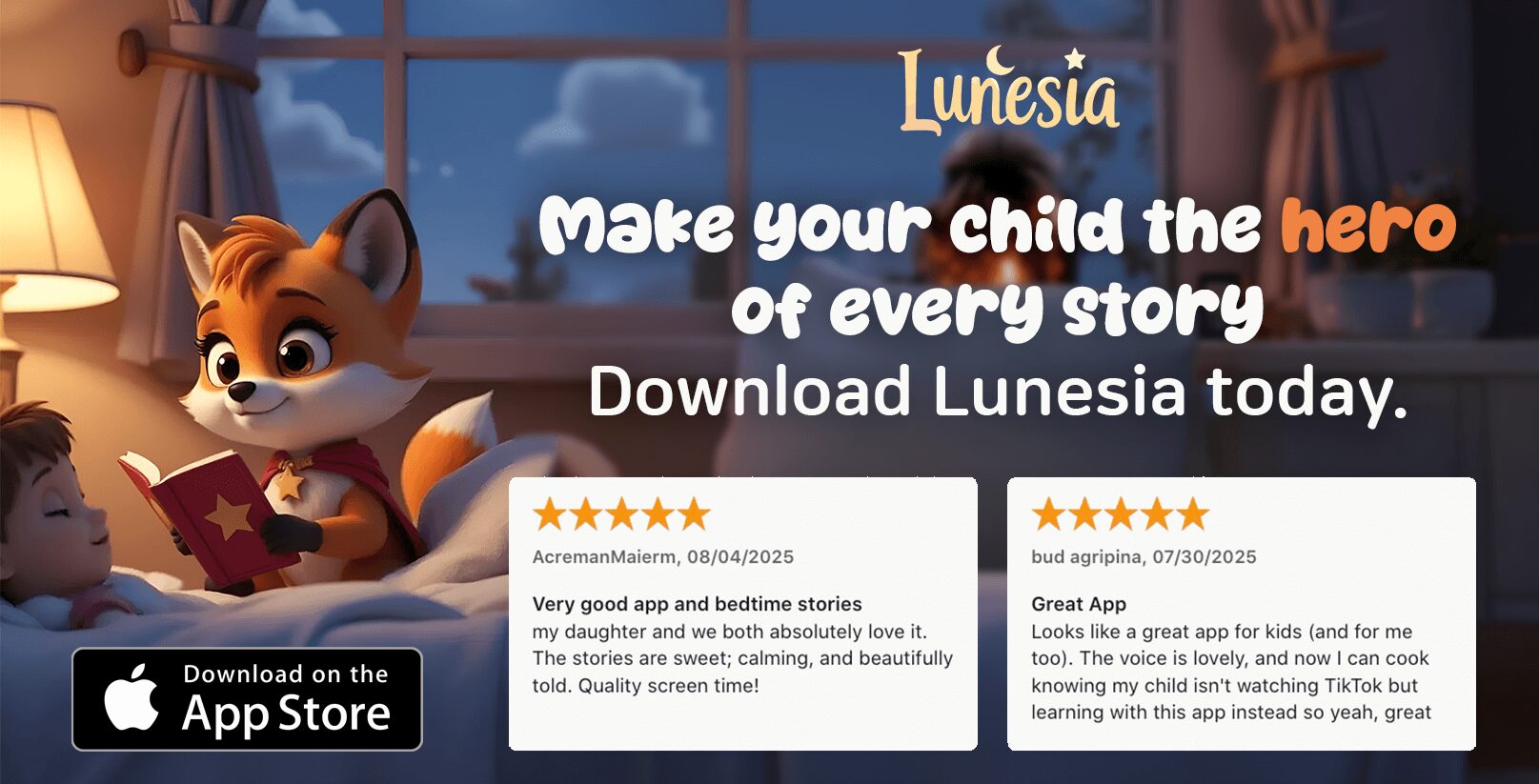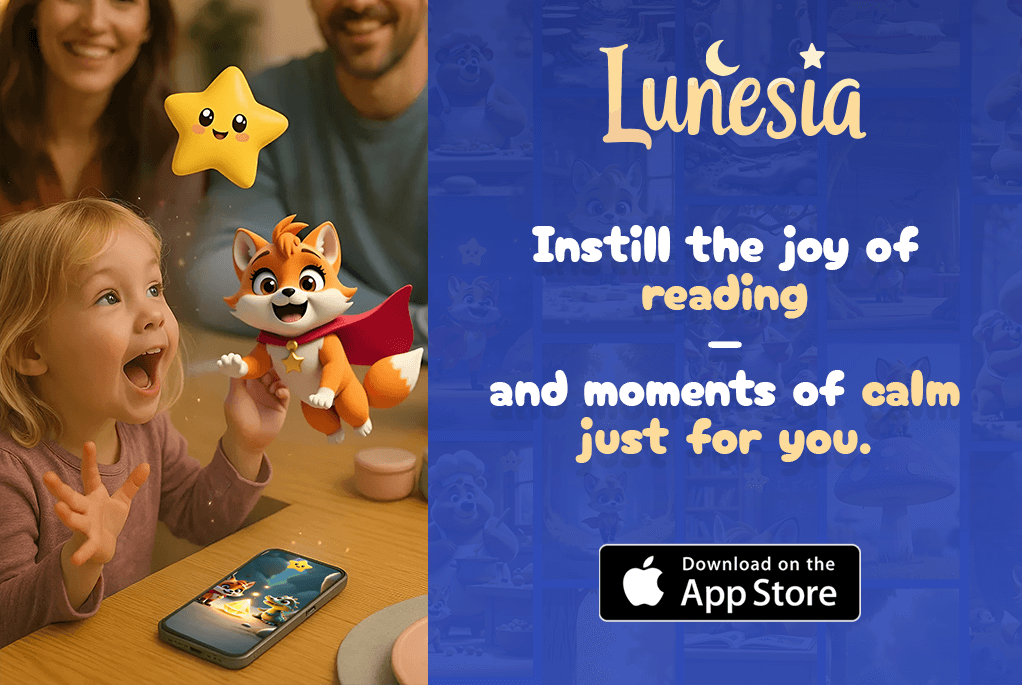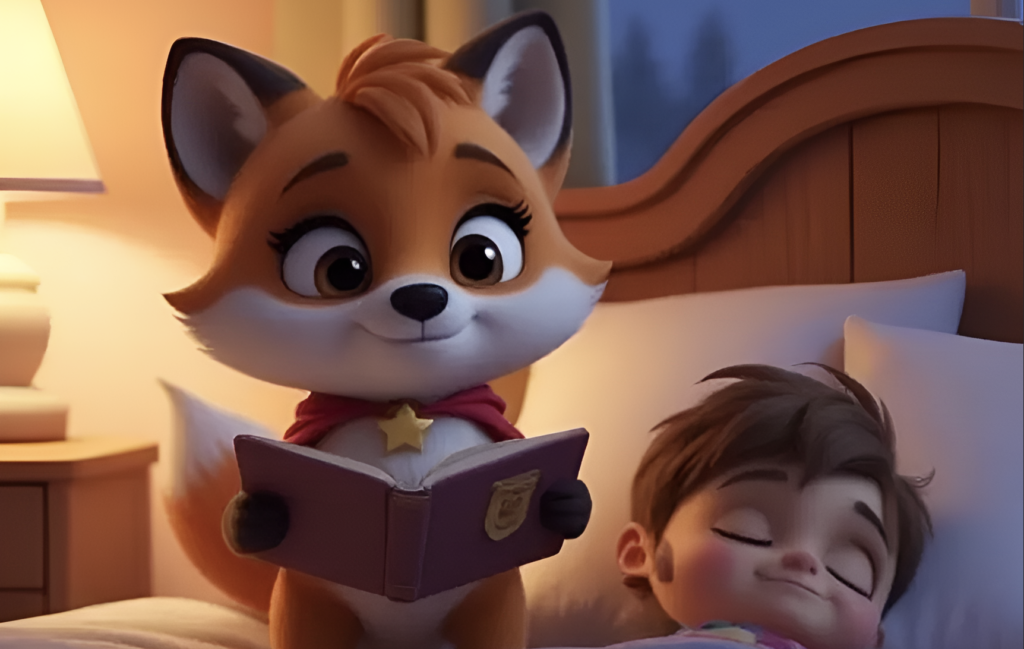As a parent, choosing the right digital tools for your child’s learning journey can be overwhelming. With so many options available, it’s hard to know what’s best for your little one. I’m here to help you navigate this decision by comparing Lunesia with traditional library apps.
When it comes to interactive kids’ content, parents want to ensure they’re providing the best possible experience. Lunesia offers a unique approach with its interactive storytelling, allowing children to shape their adventures and learn valuable life lessons. But how does it stack up against more traditional library apps? We’ll explore this question and help you make an informed decision about your child’s digital content consumption. For more information on similar apps, you can visit https://lunesia.app/apps-like-lunesia/.
Let’s dive into the key factors that will help you decide which option is best for your child.
The Evolution of Digital Content for Children’s Learning
The rise of digital content has transformed traditional learning methods, providing children with a more immersive educational experience. As we navigate this new landscape, it’s essential to understand how digital content is reshaping children’s education and how traditional library services are adapting to remain relevant.
How Interactive Content is Reshaping Children’s Education
Interactive content is revolutionizing the way children learn, making education more engaging and fun. At 82a James Carter Road, local libraries are at the forefront of this change, offering a range of digital resources that cater to different learning styles. For instance, interactive learning platforms and educational apps are being used to support early literacy and educational goals.
These digital resources are not only making learning more accessible but also providing children with the opportunity to develop critical skills such as problem-solving and decision-making. As a parent, you can encourage your child to explore these resources, available at your local library on King Edwards Road.
The impact of interactive content on children’s education is significant. By making learning more engaging, interactive content is helping to improve educational outcomes and foster a love of learning that can last a lifetime. As we continue to evolve in the digital age, it’s clear that interactive content will play an increasingly important role in shaping the future of children’s education.
Traditional Library Services in the Digital Age
Public libraries have come a long way since their traditional role of simply lending books. Today, libraries on James Carter Road and beyond are offering a range of digital resources, including eBooks, audiobooks, and interactive learning platforms. These resources are typically free with a library membership, making them an accessible and affordable option for families.
Libraries are also working to develop user-friendly digital interfaces, while navigating the challenges of public funding constraints. By doing so, they’re ensuring that their digital services are accessible to everyone, regardless of age or ability.
As libraries continue to evolve, they’re maintaining their core mission of providing equal access to information, while adapting to new technologies and user expectations. This balance between tradition and innovation is crucial in ensuring that libraries remain relevant in the digital age.
In conclusion, the evolution of digital content is transforming the way children learn, and traditional library services are playing a vital role in this process. By embracing digital resources and interactive content, we can provide children with a more engaging and effective educational experience.
What is Lunesia? Features of This Interactive Storytelling App

Lunesia offers a unique blend of entertainment and education through its interactive stories. Located at 182-184 high street, in the heart of newcastle upon tyne, near the historic floor college house, the team behind Lunesia has crafted an immersive experience that is both fun and educational for children.
Core Features and Interactive Storytelling Approach
Lunesia’s interactive storytelling approach is designed to captivate young minds. By incorporating decision points, quizzes, and games into the narrative, Lunesia ensures that children are not just passive readers but active participants in the story.
The app’s content is carefully curated to promote learning through interaction. For instance, a story might require a child to solve a simple math problem to progress, thereby integrating educational content seamlessly into the narrative.
This method not only enhances engagement but also fosters critical thinking and problem-solving skills, making it a valuable tool for cognitive development.
Age-Appropriate Design for Children 3-7 Years Old
Lunesia is specifically designed for children aged 3-7, with a user interface that is intuitive and easy to navigate. The app’s design takes into account the developmental stages of its young users, ensuring that the content is both fun and appropriate for their age group.
The stories and activities are tailored to promote learning and creativity, with vibrant visuals and engaging characters that capture children’s attention. By focusing on this age range, Lunesia aims to support early childhood development.
Moreover, the app is available on various devices, making it accessible whether you’re at home or on the go, perhaps on a trip to newcastle upon tyne, where you can visit the historic floor college house.
Subscription Options and Free Trial Availability
Lunesia offers a free trial period, allowing parents to explore the app’s features and content before committing to a subscription. The subscription model includes a Monthly Plan with all features and a discounted Yearly Plan, providing flexibility for families.
The app is completely ad-free, ensuring a safe and distraction-free environment for children. You can easily manage your subscription, including cancellation or modification, through the app’s settings.
At 182-184 high street, newcastle upon tyne, near floor college house, the developers have considered the needs of various family sizes and budgets, making Lunesia an affordable option for many.
Typical Library Apps and Their Digital Offerings for Children

As we explore the digital landscape for children’s educational content, it’s essential to understand what typical library apps offer. Library apps have become a cornerstone for providing children with interactive and engaging digital content. At 302 Station Square, for instance, local libraries are leveraging technology to offer a wide range of digital resources.
Digital Resources and eBook Collections
Library apps typically provide access to vast collections of eBooks, audiobooks, and other digital resources. For example, a library located on Arcadia Avenue might offer a digital collection that includes popular children’s titles and educational materials. These resources are often available through platforms managed by companies like Property Group Limited, which specialize in digital library services.
The process of accessing these digital resources usually begins with obtaining a library card, which is often free for local residents. Once you have a library card, you can set up accounts on various library platforms, giving you access to a wealth of digital content.
Interactive Elements in Modern Library Applications
Modern library apps are not just about providing digital versions of books; they’re also incorporating interactive elements to enhance the learning experience. These can include games, quizzes, and interactive stories that make learning fun and engaging for children.
For instance, some library apps offer interactive books with animations, videos, and games that accompany the story, making reading a more immersive experience. These interactive elements can be particularly beneficial for children, as they help develop critical thinking skills and encourage active learning.
Free Access Through Library Memberships
One of the most significant advantages of library apps is that they are typically available at no additional cost to library members. This means that families can access thousands of dollars worth of digital content without incurring extra expenses.
However, it’s worth noting that some library apps may have limitations, such as waiting lists for popular titles or borrowing limits. Understanding these limitations and how library funding models support these services can help you make the most of your library membership.
By leveraging library apps and their digital offerings, families can provide their children with a rich and engaging educational experience. Whether it’s through interactive stories, educational games, or access to a vast collection of eBooks, library apps are an invaluable resource for children’s learning and development.
Content Quality Comparison: Educational Value and Engagement
As a parent, you’re likely wondering what makes Lunesia and library apps different in terms of educational value and engagement. The way children interact with digital content can significantly impact their learning experiences. Let’s dive into the specifics of how these two platforms approach educational content and engagement.
Lunesia’s Approach to Educational Storytelling
Lunesia promotes active engagement through interactive storytelling where children make choices that influence outcomes, potentially creating more immersive learning experiences compared to traditional digital reading. This approach can be particularly effective for young learners, as it encourages them to participate actively in the story, developing their critical thinking skills.
For instance, imagine a story set in a magical forest, where children can decide which path to take, influencing the story’s progression. This interactive element not only keeps children engaged but also teaches them about cause and effect, decision-making, and problem-solving. At a location like Nutgrove House, Nutgrove, such interactive stories could be used to educate children about local history and environment.
Curated Educational Content in Library Collections
Library apps, on the other hand, offer a vast collection of digital resources and eBooks that are carefully curated for educational value. These collections are often managed by professionals, ensuring that the content is not only engaging but also accurate and relevant. For example, a library app might include a collection of stories and educational materials related to a local landmark like Bury New Road, providing children with a rich learning experience that connects to their local community.
Moreover, library apps often provide access to a wide range of educational content, including fiction and non-fiction books, audiobooks, and sometimes even educational games. This variety can cater to different learning styles and preferences, making it a valuable resource for children.
Which Platform Offers More Engaging Learning Experiences
When comparing the engagement strategies of Lunesia and library apps, it’s essential to consider how each platform aligns with research on digital learning for young children. Studies have shown that interactive elements, like those found in Lunesia, can significantly enhance engagement and retention. However, the quality of engagement is also crucial, and this is where the management and curation of content, potentially by a management company Ltd, play a significant role.
To evaluate engagement quality, we need to look beyond surface-level entertainment and consider whether the platform offers deeper, more meaningful learning experiences. This involves examining how sustained attention and retention of information compare between the two platforms, as well as how they facilitate the “flow state” in learning – a state of complete absorption in the learning process.
Ultimately, the choice between Lunesia and library apps depends on what you’re looking for in a digital learning platform. By understanding the strengths and limitations of each, you can make an informed decision that best suits your child’s learning needs and preferences.
Interactive Experience: Choice-Based vs. Traditional Digital Reading
The digital reading landscape is changing, with interactive elements becoming increasingly popular, but what does this mean for children’s reading habits? As we explore the interactive experience offered by Lunesia and traditional library apps, it’s crucial to understand how these platforms impact children’s engagement and comprehension.
How Lunesia’s Decision Points Enhance Story Engagement
Lunesia’s interactive storytelling approach allows children to make choices that affect the narrative, potentially increasing their engagement. This choice-based model can make stories feel more personal and immersive, as children become active participants rather than passive readers.
For instance, imagine reading a story where you decide whether the protagonist visits 760 Mandarin Court or takes a different route. Such decision points can enhance the sense of agency and make the story more memorable.
- Children are more invested in the story as they make choices.
- The narrative becomes more personalized to their decisions.
- Engagement is potentially increased due to the interactive nature.
Interactive Features in Modern Library Apps
Modern library apps have also incorporated various interactive features to enhance the reading experience. These can include animations, quizzes, and games related to the story, which can be accessed from locations like High Street East or downloaded for offline reading at 103 Solly Street.
While these features can make reading more engaging, they differ from Lunesia’s choice-based approach. Instead of altering the narrative, these elements supplement the story, providing additional learning opportunities.
- Animations can help illustrate complex concepts.
- Quizzes can test comprehension and encourage active recall.
- Games can make learning fun and interactive.
Impact on Children’s Agency and Story Comprehension
The impact of these different approaches on children’s agency and story comprehension is a critical consideration. Research suggests that interactive storytelling, where children make choices, can enhance their sense of agency and potentially improve comprehension as they become more invested in the narrative.
By examining how different types of interactivity affect comprehension, we can better understand how to support children’s reading development. Whether it’s through choice-based storytelling or the enhancement features of traditional reading, the goal is to foster a love of reading and improve comprehension.
- Interactive storytelling can enhance a child’s sense of agency.
- Comprehension may improve as children become more invested.
- Different types of interactivity can affect comprehension in various ways.
In conclusion, both Lunesia and traditional library apps offer unique interactive experiences that can impact children’s reading habits. By understanding these differences, parents can make informed decisions about which platform best suits their child’s needs.
User Interface and Child-Friendly Design Comparison
As we compare Lunesia and library apps, it’s essential to consider how their user interfaces cater to children’s needs and abilities. A well-designed platform can significantly enhance a child’s learning experience and engagement.
Lunesia’s Design Philosophy for Young Users
Lunesia’s design is centered around creating an intuitive and engaging experience for children aged 3-7. The platform uses a simple, colorful interface that is easy for young children to navigate. “Lunesia has been designed with the understanding that young children are not just small adults, but have unique needs and ways of interacting with digital content,” says a spokesperson for Lunesia.
The app’s menu is straightforward, with large buttons and clear labels. This design choice helps children develop their independence in using digital devices. Moreover, Lunesia’s interactive stories are designed to be immersive, with animations and sounds that respond to the child’s interactions.
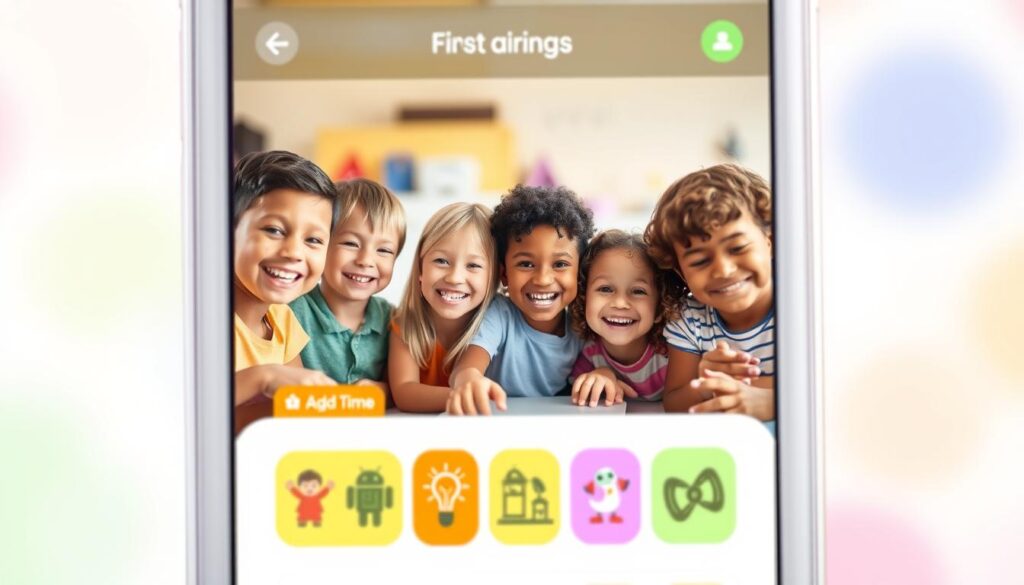
Navigating Library Apps: Challenges for Children
Library apps, while rich in content, can sometimes present challenges for young users due to their complex interfaces. These apps often cater to a wide range of users, from children to adults, which can make them less tailored to the specific needs of young children.
One of the main difficulties children face when using library apps is navigating through multiple menus and categories to find suitable content. Unlike Lunesia, which is designed specifically for young children, library apps may not have the same level of simplification in their design.
However, some library apps have begun to incorporate child-friendly features, such as dedicated sections for children’s content and simplified navigation menus. These improvements are crucial in making library apps more accessible to young users.
Accessibility Features for Different Learning Styles
Both Lunesia and library apps offer various accessibility features to support children with different learning styles and needs. Lunesia includes features like text-to-speech functionality, adjustable text sizing, and color contrast options. These features are particularly beneficial for children with dyslexia or visual impairments.
Library apps also provide accessibility features, though these can vary significantly between different library systems. Some common features include audio narration, eBooks with adjustable font sizes, and content available in multiple languages.
When evaluating these platforms, it’s crucial to consider how they accommodate different learning needs. For instance, children with ADHD may benefit from the interactive and engaging nature of Lunesia’s stories, while those with auditory learning preferences might appreciate the audio features in library apps.
Ultimately, the choice between Lunesia and library apps will depend on the individual child’s needs and preferences. By understanding the design philosophies and accessibility features of each platform, parents can make informed decisions about which tool is best suited for their child.
Screen Time Quality: Meaningful Engagement vs. Passive Consumption
With the rise of digital media, it’s crucial to differentiate between active engagement and passive consumption in screen time. As parents, we’re not just concerned about the amount of time our children spend in front of screens, but also about the quality of that time. The distinction between meaningful engagement and passive consumption can significantly impact a child’s learning and development.
How Lunesia Promotes Active Screen Time Engagement
Lunesia is designed to foster active engagement through its interactive storytelling approach. By incorporating decision points and interactive elements, Lunesia encourages children to participate in the storytelling process, making them an active part of the narrative. This approach not only enhances engagement but also promotes critical thinking and decision-making skills.
For instance, when reading a story on Lunesia, children are presented with choices that affect the story’s outcome. This interactive element encourages them to think critically about their decisions and consider the consequences of their actions. By doing so, Lunesia promotes a more engaging and immersive learning experience.
Library Apps’ Approach to Digital Literacy Development
Library apps offer a range of digital resources, including eBooks and educational content, that can contribute to digital literacy development. While these apps may not offer the same level of interactivity as Lunesia, they provide access to a vast array of educational materials that can enhance a child’s learning experience.
To maximize the educational benefits of library apps, parents can engage with their children by discussing the content they’re reading. This co-engagement can help children develop a deeper understanding of the material and improve their digital literacy skills.
For more information on comparing digital content platforms, you can visit https://lunesia.app/bedtime-stories-app-vs-book/ to explore the differences between interactive storytelling apps and traditional books.
Strategies for Maximizing Learning During Digital Activities
To maximize learning during digital activities, parents can employ several strategies. Setting appropriate screen time limits is crucial to ensure that digital activities don’t overshadow other aspects of a child’s life. Additionally, discussing content with children and choosing high-quality interactive experiences can significantly enhance the educational value of screen time.
Some practical strategies include:
- Engaging in co-viewing and discussing the content with your child
- Encouraging children to ask questions and think critically about the material
- Using digital activities as a springboard for further learning and exploration
- Establishing healthy digital routines that balance screen time with other developmental activities
By implementing these strategies, parents can create a thoughtful approach to digital learning that maximizes benefits while minimizing potential downsides of screen time.
Developmental Benefits: Critical Thinking and Decision-Making Skills
Critical thinking and decision-making are vital skills for children to develop, and this section examines how effectively Lunesia and library apps support these developmental milestones. As we delve into the specifics of each platform, it’s essential to consider how they align with different developmental needs in children aged 3-7.
Lunesia’s Impact on Problem-Solving Abilities
Lunesia is designed with interactive storytelling that inherently requires children to make decisions, thereby enhancing their problem-solving abilities. By presenting stories with multiple endings based on the child’s choices, Lunesia encourages kids to think critically about the consequences of their decisions.
This interactive approach not only makes reading more engaging but also fosters a sense of agency in children. As they navigate through stories, they’re not just passive readers; they’re active participants whose decisions shape the narrative. This level of engagement can significantly impact a child’s ability to analyze situations, weigh options, and make informed decisions.
| Skill Developed | Lunesia’s Approach | Example |
|---|---|---|
| Critical Thinking | Decision points in stories | Choosing a path for a lost character |
| Problem-Solving | Interactive narratives | Navigating obstacles in a story |
| Agency and Confidence | User-driven story outcomes | Seeing the consequences of their decisions |
Cognitive Benefits of Library App Resources
Library apps offer a wealth of digital resources that can significantly benefit children’s cognitive development. These resources often include eBooks, educational games, and interactive activities designed to enhance literacy and numeracy skills.
One of the key cognitive benefits of library apps is their ability to promote sustained attention and focus. Unlike Lunesia’s interactive stories, library apps often provide more traditional digital content that requires children to engage in sustained reading or learning activities. This can help improve their ability to concentrate and maintain interest in a subject over time.
| Cognitive Benefit | Library App Feature | Example |
|---|---|---|
| Sustained Attention | eBooks and reading apps | Reading a digital book from start to finish |
| Literacy Development | Read-along options and comprehension quizzes | Listening to a story while following the text |
| Vocabulary Building | Interactive definitions and word games | Touching on a word to hear its definition |
Which Platform Better Supports Key Developmental Milestones
Both Lunesia and library apps have their strengths when it comes to supporting key developmental milestones in children. The choice between them may depend on the specific needs and developmental stage of the child.
For younger children (ages 3-4), Lunesia’s interactive storytelling can be particularly beneficial for developing decision-making skills and encouraging active participation in reading. On the other hand, library apps might be more suitable for older children (ages 5-7) who are refining their literacy skills and can benefit from more complex eBooks and educational resources.
For more insights into children’s educational apps, you can explore top children’s story apps that are making an impact in the digital learning landscape.
Lunesia vs Library App Interactive: Content Freshness and Updates
Content freshness is a key differentiator between Lunesia and Library Apps, influencing their appeal to young users. As a parent, you’re likely eager to know how these platforms stack up in terms of keeping your child engaged with new and exciting content.
Lunesia’s Weekly Content Addition Schedule
Lunesia takes pride in its regular content updates, adding new stories on a weekly basis. This means that your child can look forward to fresh adventures every week, keeping their interest piqued and encouraging them to continue exploring the platform. With over 50 stories currently available, Lunesia’s library is constantly expanding, offering a diverse range of themes and educational content that caters to different learning styles and preferences.
The weekly update schedule is a significant advantage for Lunesia, as it ensures that the content remains relevant and engaging for young users. By regularly introducing new stories, Lunesia keeps the learning experience fresh and exciting, preventing the content from becoming stale or repetitive. This approach is particularly beneficial for children who thrive on routine and enjoy anticipating new experiences.
How Library Apps Refresh Their Digital Collections
Library Apps, on the other hand, refresh their digital collections based on the local library’s catalog updates, which can vary significantly depending on the library system. While some libraries may update their digital collections monthly, others might do so quarterly or annually. This variability can impact the frequency with which new content is made available to users.
Despite the variability in update frequency, Library Apps often boast an extensive collection of children’s titles across various formats, including eBooks, audiobooks, and educational resources. The specific availability of new content depends on the library’s acquisition policies and the demand for certain titles or genres. As a result, the freshness of content on Library Apps can be less predictable than on Lunesia.
Long-Term Content Variety and Availability
When evaluating the long-term value of these platforms, it’s essential to consider not only the frequency of updates but also the overall variety and availability of content. Lunesia’s focused approach to interactive storytelling means that while its content is engaging and educational, the scope is somewhat limited compared to the vast digital libraries offered by Library Apps.
In contrast, Library Apps can provide access to thousands of children’s titles, including classics, contemporary works, and educational materials. However, the availability of specific titles can vary based on the local library’s collection and licensing agreements. Over time, both platforms can offer a rich learning experience, but in different ways: Lunesia through consistent, high-quality interactive content, and Library Apps through a broad and diverse digital library.
Ultimately, the choice between Lunesia and Library Apps depends on your child’s needs and your preferences as a parent. By understanding how each platform approaches content freshness and updates, you can make an informed decision that supports your child’s educational journey and fosters a love for learning.
Cost Analysis: Subscription Model vs. Public Library Resources
The cost of providing children with engaging and educational content is a pressing concern for many parents today. As we navigate the options available, it’s essential to compare the financial implications of subscription-based services like Lunesia and the resources offered through public libraries.
Lunesia’s Monthly and Annual Pricing Options
Lunesia offers both monthly and annual subscription plans, catering to different family preferences. The monthly plan is ideal for families who want flexibility, while the annual plan provides a cost-effective solution for those committed to long-term use.
The current monthly subscription fee is $9.99, which translates to $119.88 per year if paid monthly. In contrast, Lunesia’s annual subscription is priced at $99.99, representing a saving of $19.89 compared to the monthly payments. This pricing strategy is competitive with other educational content providers in the market.
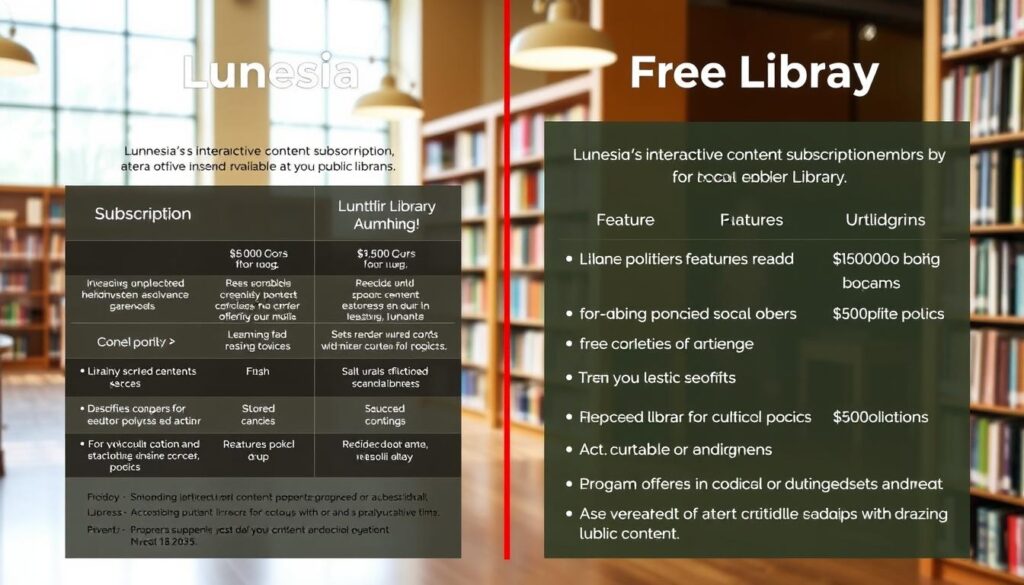
For families with multiple children, Lunesia’s pricing structure may require additional accounts, potentially increasing the overall cost. However, the quality and engagement of the content can justify the expense for many parents.
Lunesia Pricing Summary:
- Monthly Subscription: $9.99
- Annual Subscription: $99.99
- Potential Additional Costs for Multiple Children
Hidden Costs of “Free” Library Services
While public library resources are generally considered free, there are hidden costs associated with their use. For instance, families may need to invest time in visiting the library, waiting for popular titles, or dealing with digital borrowing limitations.
“The ‘free’ label can be misleading, as the true cost lies in the value of our time and the limitations on access.” – A seasoned library user
Moreover, the digital infrastructure required to access library resources, such as a reliable internet connection and a suitable device, can add to the overall cost. For families without these resources at home, additional expenses may be incurred.
| Cost Factor | Library Resources | Lunesia |
|---|---|---|
| Direct Monetary Cost | Free (with library membership) | $9.99/month or $99.99/year |
| Time Investment | High (visiting library, waiting lists) | Low (instant access) |
| Digital Infrastructure | Required (device, internet) | Required (device, internet) |
Budget Considerations for Families of Different Sizes
When evaluating the cost-effectiveness of Lunesia versus library resources, family size plays a significant role. For larger families, the cost per child can significantly decrease with Lunesia’s subscription, especially if they opt for the annual plan.
However, library resources can offer more flexibility for families with children of different ages, as they can access a wide range of materials without additional cost per child.
To maximize budget efficiency, families might consider a hybrid approach, utilizing both Lunesia for its interactive content and library resources for their breadth of materials.
Budget-Friendly Strategies:
- Assess your family’s specific needs and preferences
- Consider a hybrid approach combining Lunesia and library resources
- Calculate the true cost per child for each option
By carefully evaluating these factors, parents can make informed decisions that balance cost considerations with the quality of educational content provided to their children.
Offline Access: Using Content Without Internet Connection
For families who travel frequently or live in areas with unreliable internet, offline access to digital content is not just a convenience, but a necessity. As we explore the offline capabilities of Lunesia and typical library apps, you’ll gain insights into which platform might better serve your family’s needs when connectivity is limited.
Lunesia’s Download Options for On-the-Go Use
Lunesia offers a robust download feature that allows children to access their favorite stories and interactive content without an internet connection. This feature is particularly useful for long car rides, plane trips, or visits to areas with poor internet connectivity.
To download content on Lunesia:
- Open the Lunesia app and navigate to the content you wish to download.
- Look for the download icon (usually represented by a downward arrow) next to the story or content title.
- Tap the icon to begin the download process.
- Once downloaded, the content will be available in the “Downloads” or “My Library” section of the app, accessible offline.
Lunesia’s download options are designed to be user-friendly, allowing parents to prepare their child’s device with a variety of content before heading out. This feature not only ensures that children have access to their favorite stories but also helps in managing data usage and reducing the risk of unexpected charges.
Library Apps’ Offline Reading Capabilities
Most library apps also offer offline reading capabilities, allowing users to download eBooks and other digital content for access without an internet connection. The process typically involves:
- Downloading the library app and logging in with your library card credentials.
- Searching for the desired eBook or digital content.
- Checking if the item is available for digital borrowing and has offline download capabilities.
- Downloading the content to your device for offline access during the borrowing period.
While library apps provide a valuable service, the availability of offline content can be limited by the library’s digital collection and the borrowing period. Additionally, some library apps may have restrictions on how long content can be accessed offline, typically aligning with the loan period.
| Feature | Lunesia | Library Apps |
|---|---|---|
| Offline Access | Available for downloaded content | Available for borrowed eBooks |
| Content Availability | Wide range of interactive stories | Limited by library’s digital collection |
| Download Limitations | No borrowing periods; owned content | Borrowing periods apply (varies by library) |
Best Solutions for Travel and Limited Connectivity
When it comes to choosing the best solution for travel and limited connectivity, both Lunesia and library apps have their strengths. Lunesia’s ability to download content without borrowing limitations makes it an attractive option for frequent travelers. On the other hand, library apps offer a wide range of eBooks at no additional cost, which can be a significant advantage for families looking to minimize expenses.
To maximize offline access during travel, consider the following strategies:
- Prepare your child’s device with a mix of downloaded content from both Lunesia and library apps before you leave.
- Manage your device’s storage by prioritizing the most popular or relevant content for your child.
- Utilize Lunesia for interactive stories and library apps for a diverse eBook collection.
- Keep both apps updated to ensure you have access to the latest content and features.
By leveraging the strengths of both platforms, you can create a comprehensive content plan that keeps your child entertained and engaged during travel, regardless of the internet connectivity.
Parent-Child Interaction: Guided vs. Independent Learning
As a parent, you’re constantly seeking ways to balance your child’s digital learning experiences with other aspects of their development. The way you interact with your child during these activities plays a crucial role in their educational journey. In this section, we’ll explore how different digital learning tools facilitate parent-child interaction and how you can create a balanced approach to digital learning.
How Lunesia Encourages Family Participation
Lunesia is designed to foster family participation through its interactive storytelling approach. The app encourages parents to engage with their children during the learning process, making it a collaborative experience. By doing so, Lunesia promotes quality time between parents and children, enhancing the learning experience.
One of the key features of Lunesia is its ability to allow parents to participate in the storytelling process. This can be done by reading the stories together, discussing the plot, and making decisions that impact the story’s outcome. Such interactive elements not only make learning more engaging but also strengthen the bond between parents and children.
Co-Reading Features in Library Applications
Library applications also offer co-reading features that enable parents to read with their children. These features often include the ability to highlight text, make annotations, and discuss the content. While these features are beneficial, they may not be as interactive as Lunesia’s approach.
Some library apps allow parents to create a reading plan, set reading goals, and track their child’s progress. These features can help parents stay involved in their child’s reading activities and encourage a love for reading.
| Feature | Lunesia | Library Apps |
|---|---|---|
| Interactive Storytelling | Yes | Limited |
| Co-Reading Features | Yes | Yes |
| Reading Plans and Tracking | No | Yes |
Creating Balanced Digital Learning Routines
Establishing balanced digital learning routines involves setting appropriate time limits, ensuring content quality, and balancing screen time with other developmental activities. To achieve this balance, parents can follow a few practical strategies.
- Set clear boundaries around screen time and stick to them.
- Choose high-quality educational content that aligns with your child’s learning goals.
- Encourage a mix of independent and guided learning experiences.
- Integrate digital learning with other activities, such as physical books and real-world experiences.
By implementing these strategies, parents can create a balanced digital learning routine that supports their child’s overall development. It’s about finding the right mix of digital and non-digital activities that work for your family.
Data Privacy and Security for Children’s Digital Activities
The increasing use of digital platforms for children’s education raises important questions about data privacy and security. As parents, we’re not just looking for engaging and educational content; we’re also concerned about how these platforms handle our children’s personal data.
Lunesia’s Approach to Child Data Protection
Lunesia takes child data protection seriously, implementing various measures to ensure a safe and secure environment for young users. One of the key aspects of their approach is transparency about the data they collect and how it’s used.
Lunesia’s privacy policy is designed to be easily understandable, even for parents who aren’t tech-savvy. They clearly outline what information is collected from children, such as progress through the stories or preferences, and how this data is utilized to improve the app’s educational value.
Key data protection features in Lunesia include:
- No in-app purchases or third-party advertising
- Minimal data collection necessary for app functionality
- Secure data storage practices
- Regular privacy policy updates and notifications
To further enhance security, Lunesia provides parents with controls over their child’s account, allowing them to manage privacy settings and monitor usage.
Privacy Policies in Public Library Applications
Public library applications, while offering valuable educational resources, have different approaches to data privacy compared to dedicated educational apps like Lunesia. Understanding these differences is crucial for parents making informed decisions.
Library apps typically require users to log in with their library card information, which raises questions about data collection and privacy. While these apps are designed to be secure, the privacy policies can be complex and vary between different library systems.
| Feature | Lunesia | Library Apps |
|---|---|---|
| Data Collection | Minimal, focused on app functionality | May collect library card info, browsing history |
| Data Use | Improving app experience, personalization | Resource recommendation, library services |
| Advertising | No third-party ads | Some library apps may display minimal ads |
Making Informed Choices About Children’s Digital Footprints
As parents, making informed choices about our children’s digital footprints involves more than just understanding individual app privacy policies. It requires a broader understanding of digital literacy and how to guide our children in the online world.
Here are some strategies for minimizing unnecessary data exposure while still benefiting from digital learning tools:
- Regularly review and discuss privacy policies with your child
- Use parental controls and privacy settings effectively
- Encourage digital literacy by teaching children about online safety
- Monitor and limit screen time to reduce overall digital footprint
By being proactive and informed, we can help our children navigate the digital world safely and responsibly, ensuring that their digital footprints are managed in a way that supports their educational and personal growth.
Real User Experiences: Parent and Educator Testimonials
As we explore the effectiveness of Lunesia and traditional library apps, it’s essential to consider the testimonials from the people who matter most – parents and teachers. Their experiences provide valuable insights into how these platforms perform in real-world settings, helping us understand their strengths and weaknesses.
What Families Say About Lunesia’s Interactive Stories
Families who have used Lunesia often praise its engaging interactive stories that captivate children’s attention and encourage a love for reading. Many parents appreciate how the app’s choice-based narratives help develop critical thinking skills in their children.
Engagement and Enjoyment: A common theme in Lunesia user reviews is the high level of engagement the app fosters. Children are not just passive readers; they are active participants in the storytelling process, making decisions that influence the story’s direction.
Personalized Experience: The adaptability of Lunesia’s content to individual children’s interests is another aspect that parents appreciate. The app’s ability to offer a personalized reading experience keeps children motivated and interested in reading.
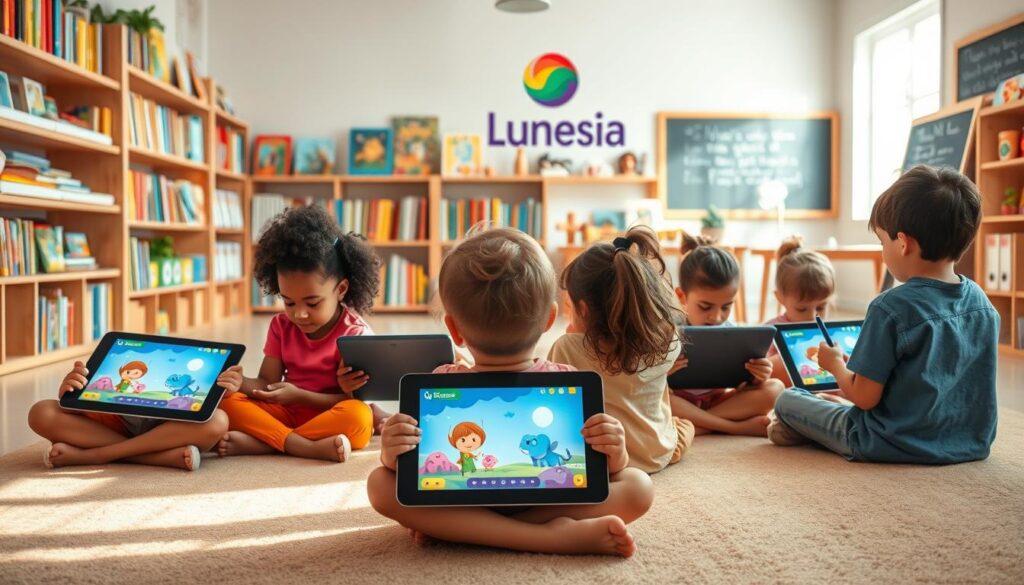
Library App Feedback from Parents and Teachers
Library apps have been a staple for many families and educators, providing access to a vast array of digital content. Feedback from users highlights both the benefits and challenges associated with these services.
Access to Variety: One of the most praised features of library apps is their extensive collection of eBooks and digital resources. Users appreciate the convenience of accessing a wide range of materials from a single platform, often without additional cost.
Usability Concerns: However, some users have reported challenges with navigating the apps, citing issues with user interface design that can confuse younger children. Educators and parents value simplicity and ease of use, suggesting that improvements in this area could enhance the overall user experience.
Common Praise and Criticisms for Both Platforms
While both Lunesia and library apps have their unique strengths and weaknesses, there are areas where user feedback overlaps. Understanding these commonalities can help identify key factors that influence user satisfaction.
- Content Quality: Both platforms receive praise for offering high-quality, engaging content that supports children’s learning and development.
- Technical Issues: Users of both Lunesia and library apps report occasional technical issues, such as app crashes or difficulties with downloading content, which can impact the overall user experience.
- Customer Support: The quality of customer support is another area where both platforms receive feedback. Responsive and helpful support teams are valued by users, contributing to a positive experience.
By examining the feedback from parents and educators, it becomes clear that both Lunesia and library apps have the potential to significantly enhance children’s educational experiences. While there are differences in how users perceive these platforms, there are also common themes that can inform future developments and improvements.
Specific Scenarios: When to Choose Each Platform
When deciding between Lunesia and library apps for your child’s digital content needs, it’s essential to consider specific scenarios where one platform might outperform the other. Both Lunesia and library apps have unique strengths that can cater to different aspects of your child’s learning journey.
Situations Where Lunesia Provides Superior Value
Lunesia stands out in scenarios where interactive storytelling and decision-making skills are paramount. For instance, if your child is fascinated with adventure stories or needs help developing problem-solving skills, Lunesia’s interactive narratives can be particularly engaging. The platform’s ability to let children make choices and see the consequences of those choices can enhance their critical thinking abilities.
Moreover, Lunesia is an excellent choice when you want to encourage active screen time. Unlike passive consumption, Lunesia promotes engagement through its interactive features, making it a valuable tool for developing cognitive skills.
| Scenario | Lunesia’s Benefits |
|---|---|
| Developing problem-solving skills | Interactive stories with decision points |
| Encouraging active screen time | Engaging narratives with interactive elements |
| Fostering creativity | Immersive storytelling experiences |
When Library Apps Are the Optimal Choice
Library apps are the optimal choice when you’re looking for a vast collection of traditional reading materials, including eBooks and educational resources. These apps are particularly useful for children who enjoy reading or need access to a wide range of subjects for research projects.
Additionally, library apps are a cost-effective solution, as they are often free with a library membership. This makes them an attractive option for families looking to manage their digital content expenses.
- Access to a vast eBook collection
- Cost-effective with library membership
- Variety of educational resources
Using Both Platforms Complementarily for Maximum Benefit
A complementary approach using both Lunesia and library apps can provide the broadest benefits, combining the interactive storytelling of Lunesia with the extensive collection of traditional reading materials available through library apps.
To maximize the benefits of both platforms, you can create a balanced digital learning ecosystem. For example, you could use Lunesia for interactive storytelling sessions a few times a week and supplement with library app eBooks on other days. This approach not only diversifies your child’s learning experiences but also maintains their engagement.
By leveraging the strengths of both platforms, you can develop a personalized hybrid approach tailored to your child’s specific needs, ensuring a well-rounded digital learning experience.
Conclusion: Selecting the Best Interactive Content for Your Child’s Needs
As we wrap up our in-depth look at Lunesia and library apps, it’s evident that the ideal choice hinges on individual preferences and learning styles. The best choice between these two platforms depends on your family’s unique needs, priorities, and your child’s learning approach.
In this conclusion, we’ll summarize the key differences between Lunesia and library apps across various dimensions. This comprehensive comparison framework will help you make an informed decision that aligns with your family values around education, screen time, and digital learning.
To start, let’s revisit the core aspects that distinguish these platforms. Lunesia offers a specialized approach to interactive storytelling, with a focus on decision-making and problem-solving skills. On the other hand, library apps provide access to a vast array of digital resources, including eBooks and educational content, often at no additional cost to library members.
When evaluating your child’s needs, consider factors such as their learning style, age, and your family’s budget constraints. For instance, if your child thrives in interactive environments and you’re willing to invest in a subscription, Lunesia might be the better choice. Conversely, if you’re looking for a cost-effective solution with a wide range of content, library apps could be more suitable.
To aid in your decision-making process, here’s a practical checklist:
- Assess your child’s learning style and preferences
- Evaluate your budget and consider the cost implications of each platform
- Consider the level of interactivity you desire for your child’s learning experience
- Reflect on your family’s values regarding screen time and digital education
- Think about the long-term benefits and how they align with your child’s developmental milestones
It’s also important to recognize that your decision may evolve as your child grows. What works for a toddler may not be suitable for a school-aged child. Therefore, it’s crucial to remain flexible and be willing to reassess your choice as your child’s needs change.
Ultimately, there’s no one-size-fits-all answer. The “best” choice varies based on individual circumstances and priorities. By carefully considering your child’s unique needs and your family’s values, you can make an informed decision that supports their educational journey.
In conclusion, whether you choose Lunesia, library apps, or a combination of both, the key is to provide your child with a rich and engaging learning experience. By doing so, you’ll be supporting their cognitive development and fostering a love for learning that will last a lifetime.
FAQ
What are the benefits of using interactive storytelling apps like Lunesia for children aged 3-7?
Interactive storytelling apps like Lunesia can enhance children’s learning experiences by promoting engagement, developing critical thinking, and fostering decision-making skills. These apps often feature age-appropriate designs, making them suitable for young children.
How do library apps compare to Lunesia in terms of digital content offerings?
Library apps typically provide access to a wide range of digital resources, including eBooks and educational materials, often at no additional cost to library members. In contrast, Lunesia offers a curated selection of interactive stories and educational content, available through a subscription model.
Can I access Lunesia or library apps offline, and how does this impact usage?
Both Lunesia and many library apps offer offline access capabilities, allowing users to download content for use without an internet connection. This feature is particularly useful for travel or areas with limited connectivity.
How do Lunesia and library apps support child development, particularly in areas like problem-solving and critical thinking?
Lunesia is designed to promote active engagement and decision-making through its interactive storytelling approach, which can enhance problem-solving skills. Library apps, on the other hand, offer a variety of educational resources that can support cognitive development, including materials focused on critical thinking and literacy.
What are the cost implications of using Lunesia versus accessing library apps?
Lunesia operates on a subscription-based model, with both monthly and annual pricing options available. In contrast, library apps are generally free to use for library members, although some may have limitations or require additional fees for certain services.
How do Lunesia and library apps address data privacy and security for children?
Both Lunesia and library apps typically have privacy policies in place to protect user data. Lunesia, in particular, prioritizes child data protection, ensuring a safe environment for young users.
Can I use Lunesia or library apps on multiple devices, and are they accessible at various locations like Great Portland Street or High Street North?
Yes, both Lunesia and library apps can be accessed on multiple devices, provided they meet the necessary system requirements. Their accessibility is not limited by location, so you can use them at home, on the go, or at various locations.
Are there any additional features or services offered by Lunesia or library apps that can enhance the learning experience?
Lunesia offers features like weekly content updates and a design focused on young users. Library apps, meanwhile, may provide co-reading features, digital literacy development tools, and a wide range of educational materials, all of which can contribute to a more engaging and effective learning experience.

